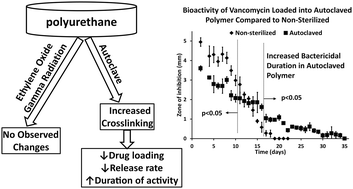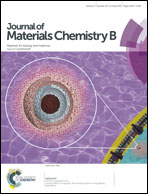Thermomechanical properties, antibiotic release, and bioactivity of a sterilized cyclodextrin drug delivery system
Abstract
Various local drug delivery devices and coatings are being developed as slow, sustained release mechanism for drugs, yet the polymers are typically not evaluated after commercial sterilization techniques. We examine the effect that commercial sterilization techniques have on the physical, mechanical, and drug delivery properties of polyurethane polymers. Specifically we tested cyclodextrin–hexamethyl diisocyanate crosslinked polymers before and after autoclave, ethylene oxide, and gamma radiation sterilization processes. We found that there is no significant change in the properties of polymers sterilized by ethylene oxide and gamma radiation compared to non-sterilized polymers. Polymers sterilized by autoclave showed increased tensile strength (p < 0.0001) compared to non-sterilized polymers. In the release of drugs, which were loaded after the autoclave sterilization process, we observed a prolonged release (p < 0.05) and a prolonged therapeutic effect (p < 0.05) but less drug loading (p < 0.0001) compared to non-sterilized polymers. The change in the release profile and tensile strength in polymers sterilized by autoclave was interpreted as being caused by additional crosslinking from residual, unreacted, or partially-reacted crosslinker contained within the polymer. Autoclaving therefore represents additional thermo-processing to modify rate and dose from polyurethanes and other materials.


 Please wait while we load your content...
Please wait while we load your content...